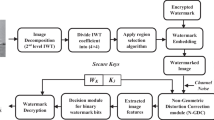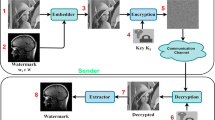Abstract
A novel image authentication scheme which can protect the image integrity of the compressed images for block truncation coding (BTC) is proposed in this paper. In the proposed scheme, the authentication codes are embedded into the the quatization levels of each BTC-compressed image block by using reference matrix– RM B . The size of the authentication codes can be decided according to the user’s requirement by adjusting the value of B in Reference Matrix. The experimental results demonstrate that the proposed method outperforms previous approaches in image quality of the embedded image and high detecting accuracy.













Similar content being viewed by others
References
Ahmed N, Natarajan T, Rao KR (1974) Discrete cosine transform. IEEE Trans Comput 100(1): 90–93
Bartolini F, Tefas A, Barni M, Pitas I (2001) Image authentication techniques for surveillance applications. Proceedings of the IEEE 89(10):1403–1418
Chang C-C, Lin C-Y, Fan Y-H (2008) Lossless data hiding for color images based on block truncation coding. Pattern Recognition 41(7):2347–2357
Delp EJ, Mitchell Robert O (1979) Image compression using block truncation coding. IEEE Trans Commun 27(9):1335–1342
Deng C, Gao X, Li X, Tao D (2009) A local tchebichef moments-based robust image watermarking. Signal Process 89(8):1531–1539
Friedman GL (1993) The trustworthy digital camera: Restoring credibility to the photographic image. IEEE Trans Consum Electron 39(4):905–910
Gao X, Deng C, Li X, Tao D (2010) Geometric distortion insensitive image watermarking in affine covariant regions. IEEE Trans Syst Man Cybern Part C Appl Rev 40(3):278–286
Gray RM (1984) Vector quantization. IEEE ASSP Mag 1(2):4–29
Haralick RM, Sternberg SR, Zhuang X (1987) Image analysis using mathematical morphology. IEEE Transactions on Pattern Analysis and Machine Intelligence 9(4):532–550
Huang H-C, Chang F-C (2014) Robust image watermarking based on compressed sensing techniques. Journal of Information Hiding and Multimedia Signal Processing 5 (2): 327–332
Hu Y-C, Lo C-C, Chen W-L, Wen C-H (2013) Joint image coding and image authentication based on absolute moment block truncation coding. Journal of Electronic Imaging 22(1):013012–013012
Hu Y-C, Lo C-C, Wu C-M, Chen W-L, Wen C-H (2013) Probability-based tamper detection scheme for btc-compressed images based on quantization levels modification. International Journal of Security & Its Applications 7 (3)
Lema M, Mitchell RO (1984) Absolute moment block truncation coding and its application to color images. IEEE Trans Commun 32(10):1148–1157
Lin C-C, Liu X-L, Tai W-L, Yuan S-M (2013) A novel reversible data hiding scheme based on ambtc compression technique. Multimedia Tools and Applications:1–20
Qin C, Chang C-C, Chen P-Y (2012) Self-embedding fragile watermarking with restoration capability based on adaptive bit allocation mechanism. Signal Process 92(4):1137–1150
Qin C, Chang C-C, Chen K-N (2013) Adaptive self-recovery for tampered images based on vq indexing and inpainting. Signal Process 93(4):933–946
Tefas A, Pitas I (2000) Image authentication and tamper proofing using mathematical morphology. In: Proceedings of European signal processing conference (EUSIPCO 2000). vol 3, p 1681–1684, Tampere, Finland
Tsui S-R, Huang C-T, Wang W-J (2013) A new adaptive steganographic method based on gradient adjacent prediction and side-match vector quantization. Journal of Information Hiding and Multimedia Signal Processing
Wolfgang RB, Delp EJ (1996) A watermark for digital images. In: Proceedings of IEEE International Conference on Image Processing, vol 3, p 219–222
Yanga C-H, Linb C-Y, Hua W-C (2012) Reversible data hiding for high-quality images based on integer wavelet transform. Journal of Information Hiding and Multimedia Signal Processing
Yeung MM, Mintzer F (1997) An invisible watermarking technique for image verification. In: Proceedings of IEEE International Conference on Image Processing, vol 2, p 680–683
Zhang X, Wang S, Qian Z, Feng G (2011) Self-embedding watermark with flexible restoration quality. Multimedia Tools and Applications 54(2):385–395
Author information
Authors and Affiliations
Corresponding author
Rights and permissions
About this article
Cite this article
Li, W., Lin, CC. & Pan, JS. Novel image authentication scheme with fine image quality for BTC-based compressed images. Multimed Tools Appl 75, 4771–4793 (2016). https://doi.org/10.1007/s11042-015-2502-z
Received:
Revised:
Accepted:
Published:
Issue Date:
DOI: https://doi.org/10.1007/s11042-015-2502-z




